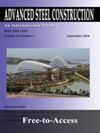建筑用隔震重型脚手架承载能力试验研究
IF 1.7
3区 工程技术
Q3 CONSTRUCTION & BUILDING TECHNOLOGY
引用次数: 4
摘要
在高间隙、大跨度、厚楼板的建筑施工阶段,为满足建筑的荷载需求,往往将具有较高承载能力的隔震重型脚手架作为构筑物。由于孤立的重型脚手架作为临时结构,在施工完成后立即拆除,其重要性往往被忽视。到目前为止,关于隔震式重型脚手架结构设计的资料还比较少,施工现场隔震式重型脚手架的装配仍然主要依靠施工人员的经验。这种现象导致了实际应用于建筑工地的孤立重型脚手架倒塌的高风险。本研究通过对建筑工地实际设置的隔离式重型脚手架进行测试,探讨了不同设置下隔离式重型脚手架的临界载荷和破坏模式。结果表明,由于隔震重型支架底座千斤顶提供的弯矩刚度可以忽略不计,因此底座千斤顶对隔震重型支架整体承载能力的影响有限。隔离式重型脚手架设置在变标高地面上或变标高倾斜顶板下的地面上时,只要标高差小于56 cm,其承载能力就不会受到很大影响。在施工现场进行多层装配时,通常采用隔离式的重型脚手架,在其顶层安装钢管支架。然而,这种组合式脚手架结构使隔离式重型脚手架的承载能力降低了70%。在这种情况下,直接延长隔离式重型脚手架的顶螺杆千斤顶比采用组合式脚手架结构效果更好。对于反复使用后的隔震重型脚手架,本研究采用重复加载试验模拟施工现场隔震重型脚手架的下界强度。在工程师设计可重复使用的隔离重型脚手架强度时,承包商可以根据成本和施工安全考虑选择适当的降低系数。本文章由计算机程序翻译,如有差异,请以英文原文为准。
EXPERIMENTAL STUDY ON LOAD CAPACITIES OF ISOLATED HEAVY-DUTY SCAFFOLDS USED IN CONSTRUCTION
The isolated heavy-duty scaffolds, which have higher load capacity, are often considered to serve as the falsework during the construction stage of a building with high clearance, large spans and thick slabs in order to meet the load demand of the building. Because isolated heavy-duty scaffolds serve as temporary structures and are promptly dismantled after the construction is complete, their importance is often neglected. Until now, data regarding the structural design of isolated heavy-duty scaffolds has been rather scarce, and the assembly of isolated heavy-duty scaffolds on construction sites still relies mainly on the experience of construction workers. This phenomenon results in a high risk of collapse of isolated heavy-duty scaffolds actually applied on construction sites. This study explores the critical loads and the failure modes of isolated heavy-duty scaffolds in various setups by testing actual setups of isolated heavy-duty scaffolds on construction sites. The results show that, since the bending moment stiffness provided by the base screw jacks of isolated heavy-duty scaffolds is negligible, the base screw jack has a limited effect on the overall load capacity of isolated heavy-duty scaffolds. When isolated heavy-duty scaffolds are set up on ground with varying elevation or on ground under an inclined top slab with varying elevation, their load capacity is not substantially affected as long as the difference in elevation is less than 56 cm. When assembled in multiple layers on construction sites, isolated heavy-duty scaffolds are often erected with steel tube shores on the top layer. However, this combined scaffolding structure reduces the load capacity of isolated heavy-duty scaffolds by as much as 70%. In this case, directly extending the top screw jacks of the isolated heavy-duty scaffolds is better than using a combined scaffolding structure. As for the isolated heavy-duty scaffolds after being repeatedly used, this study uses a repeated loading test to simulate the lower bound strength of isolated heavy-duty scaffolds on construction sites. Contractors can choose an appropriate reduction factor based on cost and construction safety considerations when engineers design the strengths of reusable isolated heavy-duty scaffolds.
求助全文
通过发布文献求助,成功后即可免费获取论文全文。
去求助
来源期刊

Advanced Steel Construction
CONSTRUCTION & BUILDING TECHNOLOGY-ENGINEERING, CIVIL
CiteScore
2.60
自引率
29.40%
发文量
0
审稿时长
6 months
期刊介绍:
The International Journal of Advanced Steel Construction provides a platform for the publication and rapid dissemination of original and up-to-date research and technological developments in steel construction, design and analysis. Scope of research papers published in this journal includes but is not limited to theoretical and experimental research on elements, assemblages, systems, material, design philosophy and codification, standards, fabrication, projects of innovative nature and computer techniques. The journal is specifically tailored to channel the exchange of technological know-how between researchers and practitioners. Contributions from all aspects related to the recent developments of advanced steel construction are welcome.
 求助内容:
求助内容: 应助结果提醒方式:
应助结果提醒方式:


